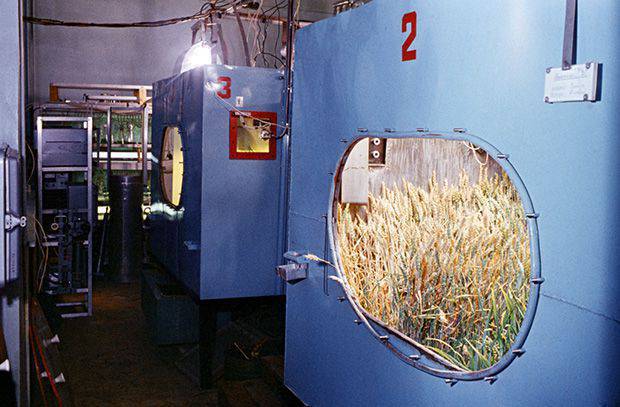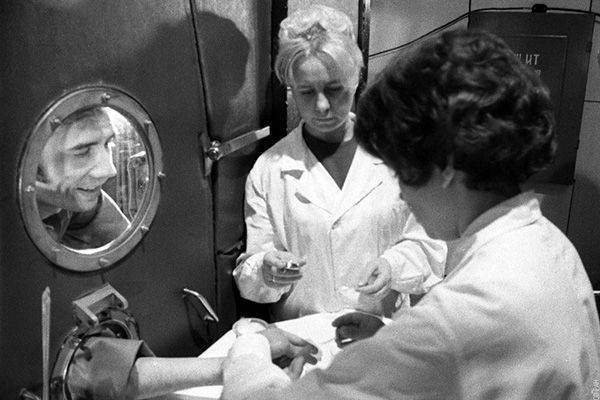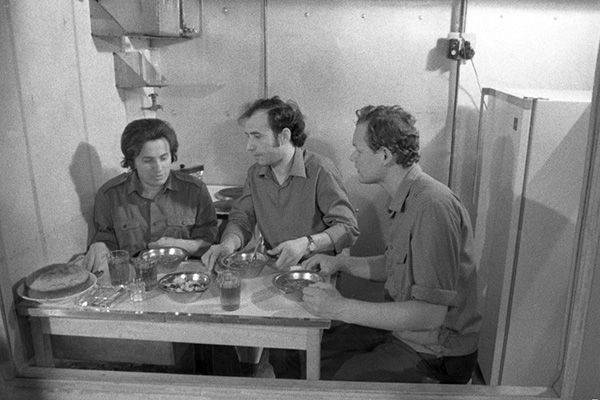Soviet Martian

How in Krasnoyarsk created the first in the world installation for autonomous survival in space
In the film Martian, the hero had to wait for the next expedition to arrive on the Red Planet with a small supply of water, food and air. American cinema tried to figure out how to do it, and Soviet scientists decided a similar task before creating a book about survival on Mars by Andy Weier.
Half a century ago, an installation was created at the Krasnoyarsk Institute of Physics of the Siberian Branch of the Russian Academy of Sciences, which would help the cosmonaut to survive on any planet without any special problems and outside help. The revolutionary, unparalleled in the world, the BIOS-3 closed-loop supply system almost completely provided the people inside it with water, oxygen, and food. It was enough to take with him a very small stock, and then everything was produced and cleaned by the system itself.
"Russian Planet" found out how Siberian scientists managed to get ahead of their time and colleagues.
Breathe with algae
“The first experiments on the creation of closed autonomous life support systems began in Krasnoyarsk at the end of 1960's,” Egor Zadereev, Ph.D. in Biological Sciences, Ph.D. in Biology, Siberian Branch of the Russian Academy of Sciences, tells the RP correspondent. - Scientists have found that in order for two people to live a year, they need about 300 kg of oxygen, 2,5 tons of water and 400 kg of food. At the same time, over the same period, they will emit 350 kg of carbon dioxide and a ton of waste that needs to be recycled. It remained to understand how to provide them with all this in an environment isolated from the outside world.
Experts conducted experiments and confirmed the hypothesis that the development potential of a living organism is higher than the realizable possibilities. When unicellular alga chlorella was placed in ideal conditions, it began to grow much faster and produce more oxygen than in the natural environment, as well as more actively process carbon dioxide.
Algae in a small tank was enough for a person to breathe normally all day, placing his face in a special hole that does not allow air to flow outside. So in 1964, they created a system with a closed reproduction cycle of oxygen "BIOS-1", which helped a person to breathe in airless space, for example, in space. Then the scientists were able to increase the time spent in a closed room from 12 hours to 30 days. Later, water exchange was also closed, which made it possible to conduct an 45 daily experience.
However, algae were useful only in order to provide humans with oxygen and rid of carbon dioxide. If there are no other plants in the closed space, then we will have to feed on algae too. It may be enough for the human body, but to maintain mental health on such a diet would be problematic.
In 1966, scientists launched experiments with vegetables and cereals, and as a result, built the installation "BIOS-2". It turned out that if the same wheat creates ideal conditions for growth - without temperature fluctuations, changing weather, weeds, then it will yield six times a year, and several times more than in natural conditions. Along the way, the researchers determined how much wheat should be sown in order to feed one person.
Bionauta in the bunker
“When Sergei Korolev, the founder of Russian cosmonautics, became aware of the experiments conducted at the Institute of Physics of the SB RAS, he became interested in them and met with the founder and director of the Krasnoyarsk Institute, academician Leonid Kirensky,” continues Yegor Zadereev. - At the personal order of the Queen, who needed an autonomous life support system for the station on the Moon, funds were allocated to continue research. They have allowed in record time, in just seven years to create an artificial ecosystem "BIOS-3".
Krasnoyarsk biophysicists received huge money for those times - 1 million rubles. With these funds, by the year 1972 they built a special bunker with stainless steel walls, isolated from the outside world, the total volume of which was a cube 315. m, and the area - 14х9х2,5 m.
The bunker was designed to stay in it three people and is divided into four parts. In one there were residential cabins with beds, a kitchen-dining room, a bathroom and a working area - a workshop-laboratory with equipment for processing the harvest, disposing of inedible biomass, as well as systems for the purification of water and air. The other three parts were intended for plants. Algae grew in a closed space and under artificial light, as well as selection varieties of soybeans, lettuce, cucumbers, radishes, carrots, beets, dill, cabbage, potatoes, onions. They regenerated water and oxygen, and also provided the “bionauts” with all the nutrients, vitamins and trace elements necessary for their existence. The dwarf wheat with a very short stem, specially bred by the Krasnoyarsk breeder Heinrich Lisovsky, also grew there: the inedible part of the ear was minimal and there was little waste. She gave a crop in 200 – 300 centners per hectare. And the Central Asian chufa herb provided people with vegetable oil.
So that people inside “BIOS” could communicate with the outside world, a sealed bunker was provided with a TV and a telephone. A cooling and power supply system was installed.
“At the beginning of 1970, three volunteers from among the employees first lived in the bunker for half a year - 180 days, from December 24 to 1972 of the year on June 22 of 1973 of the year,” says Yegor Zadereyev. - All the oxygen they breathed provided the plants they grew. They recycled carbon dioxide. Initially, the available supply of water was processed and purified to be reused.

The participants in the experiment ate vegetables grown by themselves, collected and milled wheat and baked bread from it. So they received 300 grams of bread and 400 grams of vegetables per day. Animal protein "bionavtov" provide stocks of canned and freeze-dried meat. Constantly conducted medical observations showed that such a diet, as well as processed and purified water and air did not adversely affect the health of volunteers.
The experiment lasted only six months. It became clear that there was no point in continuing it: the closed-loop life support system created in BIOS was working perfectly. The artificially created conveyor for the production of water, oxygen and food does not fail. Of course, subject to the receipt of a large amount of electricity from the outside, but this problem in space or on any of the planets is easily solved with the help of a nuclear power plant or solar panels.
Year behind hermetic door
At the station "BIOS-3", simulating an extraterrestrial settlement, 10 experiments on autonomous survival took place. They were attended by crews of one to three people. Engineer Nikolai Bugreev lived longer than the rest of the “bionavts” in “BIOS-3” - a total of 13 months.
In 1968, the Krasnoyarsk development was considered at the XIX Congress of the International Astronautical Federation as one of the possible prototypes of the biological system for providing human life at the new stage of space exploration - during long expeditions. This has become a worldwide recognition of the achievements of Siberian biophysicists.
Scientists had to solve another fundamental problem - how to provide people in a confined space with not only plant food, but also protein food. One of the creators of "BIOS-3" academician Joseph Gitelzon put forward a revolutionary idea for those times - to use for this purpose genetically modified plants that will produce the desired animal protein. The problems of natural utilization of plant biomass and the return of salt excreted from the human body into the system intrasystem mass exchange also remained unresolved.
Scientists decided to repeat a successful experiment on Earth in space. Krasnoyarsk Institute began to prepare the first containers for growing plants in zero gravity, but then perestroika broke out. Due to the complete lack of funding, unique research that had no analogs in the world at that time had to be stopped, and BIOS-3 was conserved.

Ark in the desert
Only 15 years later, in 1985, an attempt was made in the United States to conduct a similar experiment.
With the money of multi-millionaire Ed Bass in Arizona, they built a giant base "Biosphere-2" of airtight domes, which occupied an area of 12 thousand square meters. m. In this vast territory, scientists have reproduced terrestrial landscapes - desert, rainforest, savanna, even a small ocean with a coral reef, planted plants and brought hundreds of species of animals. It was assumed that all this will grow and multiply by itself and provide voluntary participants in the experiment with everything necessary for life.
“However, it soon became clear that there was a critical lack of oxygen, I had to open the windows so that the air would flow in from the outside,” says Sergei Olenin, corresponding member of the Russian Academy of Sciences. - Then the plants began to ache and die, some species of animals died out. An incredible amount of cockroaches and ants bred. Food was not enough, it had to be imported from the outside. Two years later, the experiment was discontinued, although the creators of "Biosphere-2" expected that the artificial ecosystem could survive autonomously for at least 100 years.
After the unsuccessful first attempt, the American researchers made changes to the artificial world created by them and launched the second experiment in 2007. However, he was terminated for another reason: one of the participants in the new team of volunteers attacked the others during a quarrel. After that, the investor has lost interest in the project, and now this “Noah's Ark” in the middle of the desert is visited only by tourists.
- Last year, another experiment on autonomous survival was conducted in China. He received the name "Moon Palace-1", - continues Sergey Olenin. - Scientists, who actually completely repeated the Krasnoyarsk research, managed to provide participants with all the necessary food for 75% due to the fact that the need for protein was satisfied by the worms they grew. So they managed to live in offline mode for three months.
A world for experimentation
Now the European Space Agency has begun to show interest in Krasnoyarsk research. With money received in the form of grants, small experiments are being conducted at the Institute of Biophysics of the SB RAS, modern equipment for the bunker, built at the end of 1960's, is being purchased. An artificial soil-like substrate is created for growing plants. Experiments are being conducted on the physicochemical technology of the decomposition of organic substances into minerals, which can be returned to circulation in the form of salts for plant growth. The use of land snails is being studied for the production of the protein they need
However, the full-scale research of funds is not enough - this requires several tens of millions of dollars. Everyone understands that it is necessary to resume work on the creation of closed life support systems, since without them there can be no talk of serious space exploration, but everything depends on finances. "BIOS-3" is empty. Although this is the most successful experimental system that fully meets human needs for water, air and plant food through a closed biological cycle. It could already be used, if not yet on Mars or other planets, but on Earth. After all, it can be used to reduce the environmental damage that people inevitably cause hundreds of times, since BIOS-3 allows you to consume a minimum of resources and almost do not produce waste. Houses with a closed cycle would dramatically reduce the burden on the environment, and could also provide people with everything they need where it is difficult or expensive to get, for example, in remote Arctic zones, deserts or high mountains, under water.
- Another version of the use of "BIOS" - is to conduct experiments in it, which so far no one in the world. Everyone just talks about what will happen if, for example, the level of methane in the atmosphere reaches a critical one. Will a disaster happen or not? And in Krasnoyarsk they may not argue about this, but check what happens as a result in a small closed ecosystem, - Sergey Olenin argues. - And this is just one of the possible experiments that can be even not of great, but of colossal importance for all of humanity. You can study the processes of circulation of substances in the Earth's biosphere, and not just help people survive on other planets.
Information